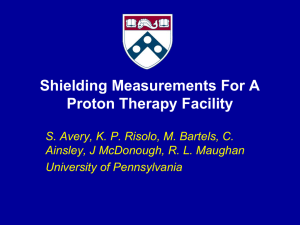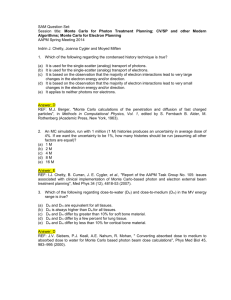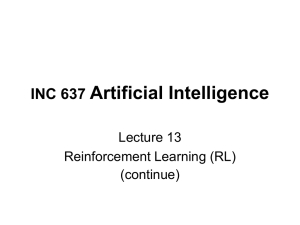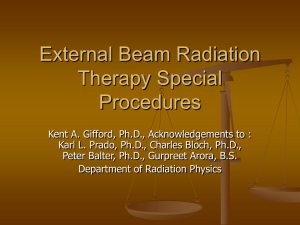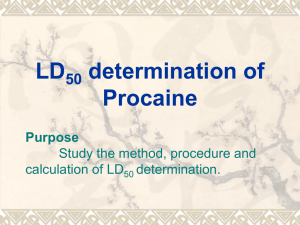Photon Beam Dose Algorithms
advertisement
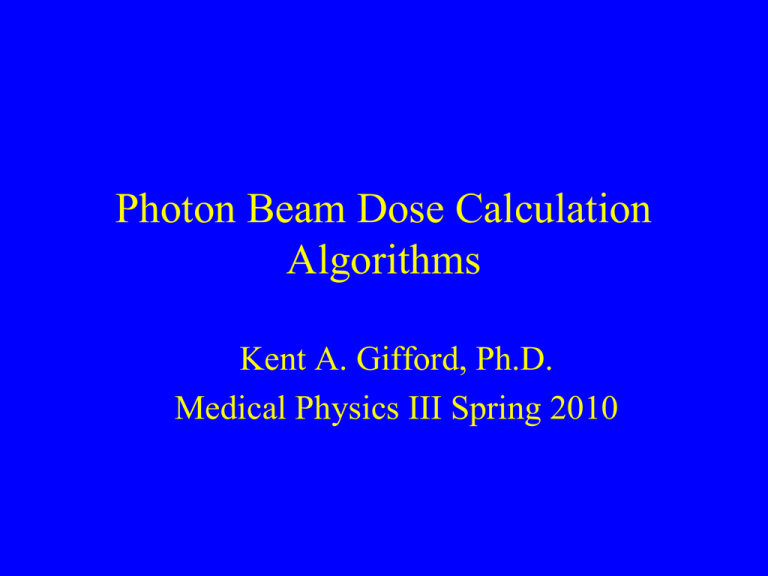
Photon Beam Dose Calculation Algorithms Kent A. Gifford, Ph.D. Medical Physics III Spring 2010 Dose Computation Algorithms I. Correction-based (Ancient!) II. Convolution (Pinnacle,Eclipse,…) III. Monte Carlo (Stochastic) IV. Deterministic (Non-stochastic) Correction-based algorithms Correction-based: Semi-empirical • Empirical: Standard measurements • Analytical: Correction factors for: • Beam modifiers: shaped blocks, wedges… • Patient contours • Patient heterogeneities Measurements • Percent Depth Dose • Lateral Dose Profiles • Beam Output Measurements • Wedge Factor Measurements Generating Functions • Convert phantom dose to patient dose Examples: – Tissue-Phantom Ratio - Attenuation – Inverse square factor – Distance – Lookup tables, e.g. off-axis factors Generating Functions • Accurate ONLY in case of electronic equilibrium – Dmax and beyond – Far from heterogeneities Issues: – Small tumors in presence of heterogeneities – Small field sizes Beam Modifier Corrections • Must correct for attenuation through beam modifiers: 1. Wedges- WF, wedged profiles 2. Compensators- attenuation measurements 3. Blocks- OF Contour Corrections Attenuation corrections due to “missing” tissue 1. Effective SSD Method • Uses PDD. Assumes PDD independent of SSD. Scales Dmax with inverse square factor. Contour Corrections 2. TMR (TAR) Ratio Method • • Exploits independence of TMR and SSD More accurate than Effective SSD method. Contour Corrections 3. Isodose Shift Method • • Pre-dates modern treatment planning systems Manual method; generates isodose curves for irregular patient contours • Greene & Stewart. Br J Radiol 1965; Sundblom Acta Radiol 1965 Contour Corrections Contour corrections 4. Effective attenuation method – – Corrects for average attenuation along beam direction Least accurate and easiest to apply Heterogeneity Corrections • One dimensional: 1. TMR ratio: CF=TMReff /TMRphysical • • Corrects for primary photon attenuation Not as accurate in heterogeneity proximity Heterogeneity Corrections Batho power law Problems with correction-based algorithms • Usually assume electronic equilibrium • Inaccurate near heterogeneities – Errors as large as 20% – Require copious measurements Convolution Algorithms • Rely on fewer measurements • Measured data: – Fingerprint to characterize beam – Model beam fluence • Energy deposition at and around photon interaction sites is computed Convolution: Explicitly Modeled Beam Features • Source size • Extrafocal radiation: – flattening filter, jaws,... • Beam spectrum– change with lateral position (flattening filter) • Collimator transmission • Wedges, blocks, compensators… Primary and Scatter Concepts • Two types of energy deposition events • Primary photon interactions. • Scatter photon interactions. r’ r Dose from Scatter Interactions • To calculate dose at a single point: – Must consider contributions of energy scattered from points over the volume of the patient. r’ r’ r’ Convolution: Volume segmented into voxels (volume elements) Primary fluence(dose) Interaction sites Dose spread array Convolution Algorithm: Heterogeneities Radiological path length Convolution Algorithm D r 3 ( r ' ) r ' ( r r ' )d r ' Primary Energy Fluence - (r’) Product of primary photons/area and photon energy Computed at all points within the patient from a model of the beam leaving the treatment head D r ( r ' ) r ' ( r r ' )d 3r ' Mass Attenuation Coefficient / (r’) Fraction of energy removed from primary photon energy fluence per unit mass Function of electron density D r ( r ' ) r ' ( r r ' )d 3r ' TERMA - T(r’) Product of Ψ(r’) and μ/ρ(r’) Total radiation Energy Released per MAss T (r ' ) (r ' ) (r ' ) It represents the total amount of radiation energy available at r’ for deposition D r ( r ' ) r ' ( r r ' )d 3r ' Convolution Kernel •Gives the fraction of the TERMA from a primary interaction point that is deposited to surrounding points •Function of photon energy and direction D r ( r ' ) r ' ( r r ' )d 3r ' primary Iso energy distribution lines.2’ interactions Convolution Superposition Algorithm • Convolution equation is modified for actual radiological path length to account for heterogeneities Dr 3 ( r ' r ' ) r 'r ' ( r r '( r r ' ))d r ' Pinnacle Convolutions • Collapsed-cone (CC) convolution – Most accurate, yet most time consuming • Adaptive convolution – Based on gradient of TERMA, compromise • Fast convolution – Useful for beam optimization and rough estimates of dose Collapsed cone approximation •All energy released from primary photons at elements on an axis of direction is rectilinearly transported and deposited on the axis. •Energy that should be deposited in voxel B’ from interactions at the vertex of the lower cone is deposited in voxel B and vice versa. •Approximation is less accurate at large distances from cone vertex. •Errors are small due to rapid falloff of point-spread functions Behavior of dose calculation algorithms near simple geometric heterogeneities • Fogliatta A., et al. Phys Med Biol. 2007 • 7 algorithms compared – Included Pinnacle and Eclipse • Monte Carlo simulations used as benchmark • 6 and 15 MV beams • Various tissue densities (lung – bone) Virtual phantom/irradiation geometry Types of algorithms considered • Type A: Electron (energy) transport not modeled • Type B: Electron transport accounted for (Pinnacle CC and Eclipse AAA). Depth dose, 15 MV, 4 cm off-axis, through “light lung”, Several algorithms • • • Problems with algorithms that do not model electron transport. Electronic equilibrium? No problem. Better agreement between Pinnacle CC and Monte Carlo than between Eclipse AAA and Monte Carlo. Conclusions • Type A algorithms inadequate inside – heterogeneous media, – esp. for small fields – type B algorithms preferable. • Pressure should be put on industry to produce more accurate algorithms Comparison of algorithms in clinical treatment planning • Knoos T, et al. Phys Med Biol 2006 • 5 TPS algorithms compared (A & B) • CT plans for prostate, head and neck, breast and lung cases • 6 MV - 18 MV photon energies used Conclusions – Algorithm comparisons for clinical cases • Prostate/Pelvis planning: A or B sufficient • Thoracic/Head & Neck – type B recommended • Type B generally more accurate in the absence of electronic equilibrium Monte Carlo (Gambling) Particle Interaction Probabilities Monte Carlo 100 20 MeV photons interacting with water. Interactions: • τ, Photoelectric absorption (~0) • σ, Compton scatterings (56) • π, Pair production events (44) Monte Carlo Indirect Use of Monte Carlo • Energy deposition kernels D r 3 ( r ' ) r ' ( r r ' )d r ' Comparisons of Algorithms Monte Carlo and Convolution Direct Monte Carlo Planning Pros Cons Can model “everything” Requires lots of histories Accuracy improved by tracing lots of particle histories Computation times, limited by computer capabilities Fundamentals Linear Boltzmann Transport Equation (LBTE) ↑direction ↑Angular ↑position ↑particle vector ↑macroscopic fluence vector energy rate extrinsic ↑scattering totalsource cross section ↑ source Streaming Collision Sources Obeys conservation of particles • Streaming + collisions = production Transport Examples Methods and Materials (External beam-Prostate) Transport Examples Methods and Materials (External beam-Prostate) Transport Examples Results (External beam-Prostate) Transport Examples Methods and Materials (Brachytherapy-HDR) Dimensions in cm Results Attila (S16) vs. MCNPX Run time*: 13.7 mins, 97% points w/in 5%, 89% w/in ±3% *MCNPX: 2300 mins References (1/2) • • • • • • • • • • • • The Physics of Radiation Therapy, 2nd Ed., 1994. Faiz M. Khan, Williams and Wilkins. Batho HF. Lung corrections in cobalt 60 beam therapy. J Can Assn Radiol 1964;15:79. Young MEJ, Gaylord JD. Experimental tests of corrections for tissue inhomogeneities in radiotherapy. Br J Radiol 1970; 43:349. Sontag MR, Cunningham JR. The equivalent tissue-air ratio method for making absorbed dose calculations in a heterogeneous medium. Radiology 1978;129:787. Sontag MR, Cunningham JR. Corrections to absorbed dose calculations for tissue inhomogeneities. Med Phys 1977;4:431. Greene D, Stewart JR. Isodose curves in non-uniform phantoms. Br J Radiol 1965;38:378 Early efforts toward more sophisticated pixel-by-pixel based dose calculation algorithms. Cunningham JR. Scatter-air ratios. Phys Med Biol 1972;17:42. Wong JW, Henkelman RM. A new approach to CT pixel-based photon dose calculation in heterogeneous media. Med Phys 1983;10:199. Krippner K, Wong JW, Harms WB, Purdy JA. The use of an array processor for the delta volume dose computation algorithm. In: Proceedings of the 9 th international conference on the use of computers in radiation therapy, Scheveningen, The Netherlands. North Holland: The Netherlands, 1987:533. Kornelson RO, Young MEJ. Changes in the dose-profile of a 10 MV x-ray beam within and beyond low density material. Med Phys 1982;9:114. Van Esch A, et al., Testing of the analytical anisotropic algorithm for photon dose calculation. Med Phys 2006;33(11):4130-4148. References (2/2) • • • • • • • Fogliatta A, et al. On the dosimetric behaviour of photon dose calculation algorithms in the presence of simple geometric heterogeneities: comparison with Monte Carlo calculations. Phys Med Biol. 2007; 52:1363-1385. Knöös T, et al. Comparison of dose calculation algorithms for treatment planning in external photon beam therapy for clinical situations. Phys. Med. Biol. 2006; 51:5785-5807. CC Convolution Ahnesjö A, Collapsed cone convolution of radiant energy for photon dose calculation in heterogeneous media. Med. Phys. 1989; 16(4):577-592. Mackie TR, Scrimger JW, Battista JJ. A convolution method of calculating dose for 15-MV x-rays. Med Phys 1985; 12:188. Mohan R, Chui C, Lidofsky L. Differential pencil beam dose computation models for photons. Med Phys 1986; 13:64. Lovelock DMJ, Chui CS, Mohan R. A Monte Carlo model of photon beams used in radiation therapy. Med Phys 1995;22:1387.
